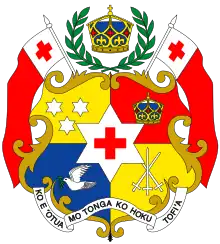 |
|---|
| Constitution |
| Administrative divisions |
Electoral system
The Legislative Assembly had seven directly-elected members; three representing Tongatapu and nearby islands, two representing Haʻapai and two representing Vavaʻu and nearby islands.[2] A further seven members were elected by the nobility based on the same constituencies,[2] seven ministers (including the governors of Haʻapai and Vavaʻu) and a Speaker chosen by the monarch, Sālote Tupou III.[3]
Results
| Constituency | Elected members | |
|---|---|---|
| Commoners | ||
| Haʻapai | Pousima 'Afeaki | |
| Latunipulu 'Unga | ||
| Tongatapu | Molitoni Finau | |
| Tu'ilatai Mataele | ||
| Sekonaia Tu'akoi | ||
| Vavaʻu | S. Fakalata | |
| Lataipouono Niusini | ||
| Nobles | ||
| Haʻapai | Tuita | |
| Tu'iha'ateiho | ||
| Tongatapu | Fielakepa | |
| Semisi Fonua | ||
| Ma'afu | ||
| Vavaʻu | Talolakepa Fulivai | |
| Tongaleva Luani | ||
| Source: Colonial Office[4] | ||
References
- ↑ Tongan Elections Pacific Islands Monthly, July 1963, p5
- 1 2 New Tongan Parliament Elected Pacific Islands Monthly, June 1948, p74
- ↑ Tonga Elects New Parliament: History of the Growth of Democracy Recalled Pacific Islands Monthly, July 1948, pp21–22
- ↑ Tonga: Report for the years 1962 and 1963, Stationery Office, p66
This article is issued from Wikipedia. The text is licensed under Creative Commons - Attribution - Sharealike. Additional terms may apply for the media files.